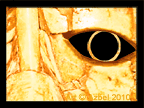Foto: Skeleton Death God, from
the Metropolitan Vase source: hamline.edu
The Cool Dark Face of Intrigue: Mayan Use of Caves and Rock Art at
Nueve Cerros
Greg Schwab, MS, Archaeology, St. Cloud
State U; 2008 recipient of the Dennis Puleston Award for Excellence in
Mesoamerican Studies
Gregory
Schwab will discuss the Mayan use of caves for the creation of rock art. Past
research has demonstrated that the Maya revered caves and used them exclusively
for the practice of ritual. Decipherments of Mayan hieroglyphs have added to a
body of evidence that has come to understand caves as the original temples,
built naturally from the landscape and mimicked by the monumental temple
architecture of Mayan civic centers. Schwab’s research addresses Mayan rock art
discovered within several caves of the karst ridge system adjacent to Salinas de
los Nueve Cerros (Saltplain of the Nine Hills). In addition to some possible
symbolic meanings of the art, he will discuss the most likely practical purpose
of Mayan rock art, asking, “What human behavior can be drawn from the analysis
of this painted and carved tradition?”.
Friday, February 15, 2013,
7:30 pm, 100E Giddens Learning Center, Hamline. Members,
students free; visitors $5.





























































































































































































































